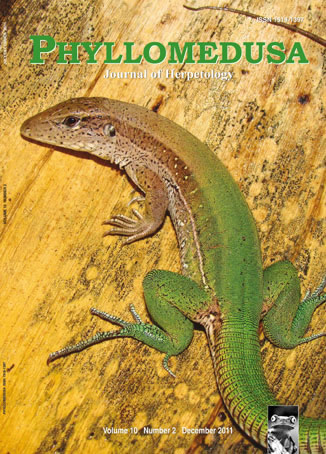Osteology and chondrocranial morphology of Gastrophryne carolinensis (Anura: Microhylidae), with a review of the osteological diversity of New World microhylids
DOI:
https://doi.org/10.11606/issn.2316-9079.v10i2p99-135Keywords:
Adult osteology, Gastrophryninae, larval chondrocranium, osteological diversity, phylogeny, skeletogenesis.Abstract
Microhylidae is a large, cosmopolitan anuran family. Recent molecular analyses have demonstrated the monophyly of the family—a conclusion that is supported by the larval morphology, coupled with the unique mode of tongue protrusion in adults, and a suite of osteological and myological characters seemingly associated with this innovation in feeding. Despite this functional constraint, osteological diversity probably exceeds that of any other anuran family, and this diversity is especially evident in the New World microhylids that comprise two clades, Gastrophryninae and Otophryninae. To facilitate comparisons among these clades, we describe the larval chondrocranium, skeletal development, and adult osteology of Gastrophryne carolinensis. We provide a phylogenetic context for these comparisons through a novel phylogenetic analysis of 45 microhylid genera based on data for one mitochondrial and three nuclear loci from previously published studies. Nearly all relationships within the monophyletic Gastrophryninae are resolved with robust support. Based on these results, we found that the larval chondrocrania of gastrophrynines share morphological features that distinguish them from Otophryne and other anurans. Among the adults, all gastrophrynines show evidence of an anterior shift of the jaws that is correlated with specializations in the otic region, and with the alignment ofthe planum antorbitale, the cartilage wall separating the nasal capsule from the orbits. The larval infrarostral and the adult mandibles lack a typical anuran mandibular symphysis, and
the mentomeckelian bone of the adult is modified with a special process. The most variable part of the skull is the palate in which a neopalatine usually is absent and the vomer may be single or divided. The posteromedial processes of the hyoids of gastrophynines tend to be elaborated, and some taxa bear a peculiar transverse slit in the posterior part of the
hyoid corpus. The anterior zonal elements of the pectoral girdle are reduced or absent, and the posterior parts enlarged and shifted posteriorly. Most taxa have eight presacral vertebrae;
depending on the taxon the last presacral is amphicoelous or procoelous.
Downloads
Download data is not yet available.
Downloads
Published
2012-10-10
Issue
Section
Articles
License
All material originally published in Phyllomedusa belongs to Escola Superior de Agricultura Luiz de Queiroz - Universidade de São Paulo. All contents are under a license of Creative Commons BY-NC-ND.How to Cite
Trueb, L., Diaz, R., & Blackburn, D. C. (2012). Osteology and chondrocranial morphology of Gastrophryne carolinensis (Anura: Microhylidae), with a review of the osteological diversity of New World microhylids. Phyllomedusa: Journal of Herpetology, 10(2), 99-135. https://doi.org/10.11606/issn.2316-9079.v10i2p99-135



 Impact Factor (JCR): 0.400
Impact Factor (JCR): 0.400 CiteScore: 1.0
CiteScore: 1.0